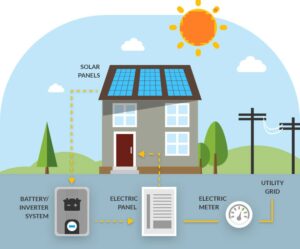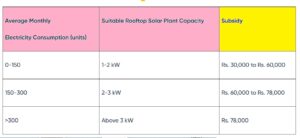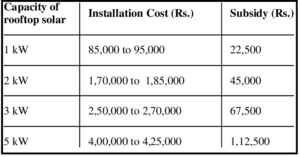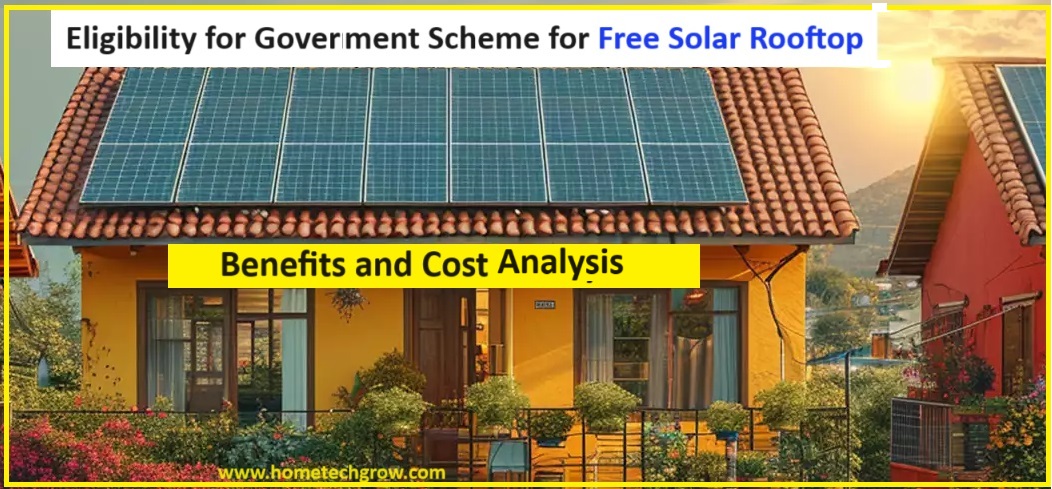What is the solar subsidy in India?
- Solar energy is produced from photovoltaic cells and is beneficial for sunny countries.
Central Financial Assistance (CFA):
- The Ministry of New and Renewable Energy (MNRE) in India offers subsidies in the form of central financial assistance for both grid-connected and off-grid solar projects.
- These subsidies help reduce the initial cost of installing solar power systems.
- You can save up to Rs 18000 a year in electricity bills via Pradhan Mantri Suryodaya Yojana (PM SY) rooftop solar power scheme

Government Schemes for Free Rooftop Solar Panels
State-Level Subsidies:
- Many Indian states provide additional subsidies and incentives on top of the central subsidies offered by the MNRE.
- These state-level subsidies vary depending on the state’s renewable energy policies and objectives.
Net Metering Policies:
- Many states in India have implemented net metering policies, allowing solar power system owners to feed excess electricity generated by their systems back into the grid.
- The electricity exported to the grid is credited to the owner’s electricity bill, effectively reducing their electricity costs.
Accelerated Depreciation Benefits:
- Businesses investing in solar power projects in India can benefit from accelerated depreciation benefits, allowing them to claim higher depreciation rates on their solar assets.
- This helps reduce tax liabilities and improves the financial viability of solar investments.
Renewable Energy Certificates (RECs):
- Solar power producers in India can earn Renewable Energy Certificates (RECs) for the electricity they generate.
- These certificates can be sold to obligated entities such as power distribution companies to meet their renewable energy purchase obligations.
Interest Subsidy for Solar Rooftop Systems:
- The Indian government provides interest subsidies on loans taken for the installation of rooftop solar systems.
- This reduces the cost of financing and makes solar installations more affordable for residential and commercial consumers.
Customs and Excise Duty Exemptions:
-
- Solar equipment and components imported into India are often exempted from customs and excise duties, reducing the overall cost of solar projects.

Eligibility for Government 2024 Scheme for Free Solar Rooftop
Eligibility for Free Solar Rooftop Yojana 2024
- This scheme offers a 40% subsidy for solar panels up to 3 KW.
- The scheme also offers a 20% government subsidy for installing solar plants up to 500 kW
- To set up a solar rooftop panel, a minimal area of 10 square meters is required under Free Solar Rooftop Yojana 2024 to put in a 1-kilowatt solar gadget.
- Under this scheme, the significant authorities will offer a subsidy of 40% for putting in solar panels up to 3 kilowatts.
- Additionally, a Free Solar Rooftop Yojana Subsidy 2024 of 20% may be given for putting in solar panels from 4 kilowatts to 10 kilowatts.
- Installing a solar system in places of work and massive factories can reduce energy bills by 30% to 50%.

Eligibility Criteria
- An Indian citizen living in India
- He or she should belong to poor and middle-income households
- They should have their home in India
Benefits of Free Solar Rooftop Energy
- The term “Free Solar Rooftop” typically refers to solar arrangements where a third-party company installs and owns the solar panels on a user’s rooftop.
- Users, whether homeowners or businesses, can benefit from this model in several ways:
Zero Upfront Costs:
-
- Users do not have to pay the upfront costs associated with purchasing and installing solar panels. The third-party company covers the initial investment, making solar energy accessible to a broader range of users.
Immediate Cost Savings:
- Users can start saving on their electricity bills immediately after the solar panels are installed.
- The third-party provider typically sells solar-generated electricity to the user at a rate lower than the local utility’s retail rate, resulting in immediate cost savings.

Reduced Electricity Bills:
- By utilizing solar energy, users can significantly reduce their dependency on traditional grid electricity.
- This reduction in grid usage translates to lower electricity bills over the long term.
- Lower energy bills: Solar panels can reduce energy bills by 30–50%.
- A 3 kW system can generate more than 300 units of power per month
- It can save households an estimated Rs 15,000–18,000 per year.

No Maintenance Responsibilities:
- The third-party company is responsible for the maintenance, repairs, and monitoring of the solar system.
- Users don’t have to worry about the technical aspects of system upkeep, as it is the responsibility of the solar provider.
Performance Guarantees:
- Many third-party solar providers offer performance guarantees, ensuring a certain level of electricity production.
- If the solar system fails to meet agreed-upon performance standards, the provider may compensate the user accordingly.
Environmental Impact:
- Users contribute to environmental sustainability by using solar energy, which is a clean and renewable source of power.
- This choice helps reduce carbon emissions and supports eco-friendly practices.
Stable Energy Costs:
-
- The third-party solar arrangement may include fixed or escalating rates for solar electricity over the contract term. This stability protects users from fluctuations in utility rates, providing a level of financial predictability.
Hassle-Free Operation:
-
- Users can enjoy the benefits of solar energy without the responsibilities of system ownership. The third-party provider handles all aspects, from installation to maintenance, allowing users to focus on their daily activities.
Potential for System Upgrades:
-
- Some agreements with third-party providers may allow users to upgrade or expand their solar systems in the future. This flexibility can be beneficial for users looking to increase their solar capacity as their energy needs grow.
Supports Renewable Energy Goals:
-
- By opting for a solar rooftop arrangement, users actively contribute to the adoption of renewable energy, supporting broader sustainability goals and helping reduce dependence on non-renewable energy sources.

Summary
- It’s important to note that the availability and specifics of subsidies and incentives for solar energy in India may change over time as government policies evolve.
- Prospective solar power system owners and developers should consult with relevant government authorities and industry experts to understand the latest subsidy schemes and incentives applicable to their projects.
- It’s crucial for users to carefully review the terms and conditions of any third-party solar agreement, including contract duration, rates, and potential ownership options. While the “Free Solar Rooftop” model offers numerous advantages, users should ensure that the arrangement aligns with their preferences and financial goals.

